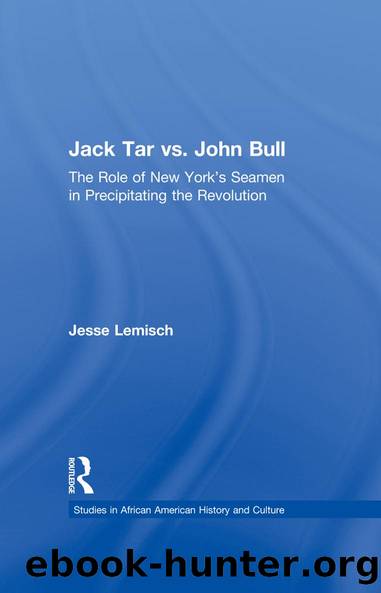Jack Tar vs. John Bull by Jesse Lemisch

Author:Jesse Lemisch [Lemisch, Jesse]
Language: eng
Format: epub
Tags: History, General
ISBN: 9781317731900
Google: pKRsBgAAQBAJ
Publisher: Routledge
Published: 2015-01-28T01:24:52+00:00
Who and Why
The swift return of peace surprised Colden not a bit. That the mob should disappear as soon as the stamps were in the City Hall was a clue to the identity of those responsible for the rioting: â⦠the Lawyers of this Place are the Authors, Promoters and Leaders.â¦â When McEvers resigned the Lieutenant-Governor had realized that âa few Menâ were stirring up the people of New York. Thereafter the newspapers were filled with articles âexciting the People to disobedience of the Laws and sedition.⦠I am persuaded some of the most popular lawyers are the Authors of the seditious Papersâ¦.â The Lawyers stirred up the lower classesâthey were âeasily ⦠seducedââand now it was questionable whether the lawyers could protect themselves against the destructive forces which they had aroused.96
Coldenâs theory was in part a reflection of, and in part a source of, what came to be the English official view of the Stamp Act riots. The theory had three aspects. First, the real leaders were members of the upper class: âseveral Persons of Consequenceâ (Sir William Johnson); âthe wiser and better Sortâ (General Gage); âsome Gentlemen of Propertyâ (Colden); Moore doubted that the apparent leaders were the real leaders, for they were not of enough âConsequence.â And among the upper class it was the Lawyers who were âPlanners and Incendiariesâ: so John Montresorâs friends told him. Second, the people were somewhat cynically used by these âRingleaders,â who âexcitedâ and âfomentedâ the mobs. Finally, since the lower class was originally misled toward violent action in behalf of a cause in which they had no real interest, they easily turned to violence for its own sake, thus frightening and disaffecting the upper class which had aroused them. This was the theory of the Stamp Act riots on which the British government acted. It was summarized by General Gage:
The Plan of the People of Property has been to raise the lower Class to prevent the Exertion of the Laws, and as far as Riots and Tumults went against Stamp-Masters and other Obstructions to the Issuing of the Stamps, they encouraged, and many perhaps Joined them. But when they tended towards Proceedings which might be deemed Treasonable or Rebellious, Persons and Propertys being then in Danger, they have endeavored to restrain them.97
When Colden spoke of popular lawyers, there was no mistaking whom he meant. âThree popular lawyersââWilliam Livingston, John Morin Scott, and William Smith, Jr.âhad come from Yale (that ânursery of sedition,â according to a conservative) to oppose him on every major public issue of the mid-century period. The New York Triumvirate (âthe wicked triumvirateâ to Dr. Samuel Johnson of Kingâs College) were Coldenâs candidates for leadership, but he could not have been more wrong. Livingstonâs position, for instance, was a liberal one, but it stopped far short of the radicalism necessary to promote an attack on the Kingâs Fort. When Colden spoke of papers in which the people were excited to sedition, he meant especially Livingstonâs series, âThe Sentinel,â in
Download
This site does not store any files on its server. We only index and link to content provided by other sites. Please contact the content providers to delete copyright contents if any and email us, we'll remove relevant links or contents immediately.
Phoenicians among Others: Why Migrants Mattered in the Ancient Mediterranean by Denise Demetriou(583)
Verus Israel: Study of the Relations Between Christians and Jews in the Roman Empire, AD 135-425 by Marcel Simon(581)
Caesar Rules: The Emperor in the Changing Roman World (c. 50 BC â AD 565) by Olivier Hekster(565)
american english file 1 student book 3rd edition by Unknown(547)
Basic japanese A grammar and workbook by Unknown(512)
Europe, Strategy and Armed Forces by Sven Biscop Jo Coelmont(509)
Banned in the U.S.A. : A Reference Guide to Book Censorship in Schools and Public Libraries by Herbert N. Foerstel(474)
Give Me Liberty, Seventh Edition by Foner Eric & DuVal Kathleen & McGirr Lisa(472)
The Roman World 44 BC-AD 180 by Martin Goodman(465)
Reading Colonial Japan by Mason Michele;Lee Helen;(461)
DS001-THE MAN OF BRONZE by J.R.A(455)
The Dangerous Life and Ideas of Diogenes the Cynic by Jean-Manuel Roubineau(446)
Introducing Christian Ethics by Samuel Wells and Ben Quash with Rebekah Eklund(443)
Imperial Rome AD 193 - 284 by Ando Clifford(436)
The Oxford History of World War II by Richard Overy(436)
Literary Mathematics by Michael Gavin;(400)
Catiline by Henrik Ibsen--Delphi Classics (Illustrated) by Henrik Ibsen(396)
Language Hacking Mandarin by Benny Lewis & Dr. Licheng Gu(391)
How to Reach the 9.0 in IELTS Academic Reading by IELTS Medical(364)
